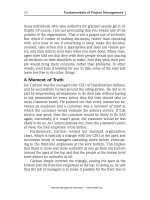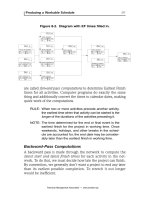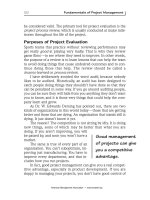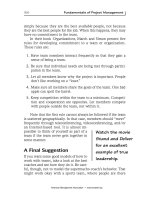IT project management 3rd by THompson chappter 11
Bạn đang xem bản rút gọn của tài liệu. Xem và tải ngay bản đầy đủ của tài liệu tại đây (492.04 KB, 39 trang )
Chapter 11:
Project Risk Management
Learning Objectives
• Understand what risk is and the importance of good project
risk management
• Discuss the elements involved in risk management planning
• List common sources of risks on information technology
projects
• Describe the risk identification process and tools and
techniques to help identify project risks
• Discuss the qualitative risk analysis process and explain
how to calculate risk factors, use probability/impact
matrixes, the Top Ten Risk Item Tracking technique, and
expert judgment to rank risks
Learning Objectives
• Explain the quantify risk analysis process and how to
use decision trees and simulation to quantitative risks
• Provide examples of using different risk response
planning strategies such as risk avoidance, acceptance,
transference, and mitigation
• Discuss what is involved in risk monitoring and control
• Describe how software can assist in project risk
management
• Explain the results of good project risk management
The Importance of Project Risk
Management
• Project risk management is the art and science of identifying,
assigning, and responding to risk throughout the life of a
project and in the best interests of meeting project objectives
• Risk management is often overlooked on projects, but it can
help improve project success by helping select good projects,
determining project scope, and developing realistic estimates
• A study by Ibbs and Kwak show how risk management is
neglected, especially on IT projects
• KPMG study found that 55 percent of runaway projects did
no risk management at all
Table 11-1. Project Management Maturity
by Industry Group and Knowledge Area
What is Risk?
• A dictionary definition of risk is “the
possibility of loss or injury”
• Project risk involves understanding
potential problems that might occur on the
project and how they might impede project
success
• Risk management is like a form of
insurance; it is an investment
Risk Utility
• Risk utility or risk tolerance is the amount of
satisfaction or pleasure received from a potential
payoff
– Utility rises at a decreasing rate for a person who
is risk-averse
– Those who are risk-seeking have a higher
tolerance for risk and their satisfaction increases
when more payoff is at stake
– The risk-neutral approach achieves a balance
between risk and payoff
Figure 11-1. Risk Utility
Function and Risk Preference
What is Project Risk Management?
The goal of project risk management is to minimize potential risks while
maximizing potential opportunities. Major processes include
– Risk management planning: deciding how to approach and plan the risk
management activities for the project
– Risk identification: determining which risks are likely to affect a project and
documenting their characteristics
– Qualitative risk analysis: characterizing and analyzing risks and prioritizing their
effects on project objectives
– Quantitative risk analysis: measuring the probability and consequences of risks
– Risk response planning: taking steps to enhance opportunities and reduce threats
to meeting project objectives
– Risk monitoring and control: monitoring known risks, identifying new risks,
reducing risks, and evaluating the effectiveness of risk reduction
Risk Management Planning
• The main output of risk management planning is a risk
management plan
• The project team should review project documents and
understand the organization’s and the sponsor’s
approach to risk
• The level of detail will vary with the needs of the
project
Table 11-2. Questions Addressed
in a Risk Management Plan
Contingency and Fallback Plans,
Contingency Reserves
• Contingency plans are predefined actions that the
project team will take if an identified risk event occurs
• Fallback plans are developed for risks that have a high
impact on meeting project objectives
• Contingency reserves or allowances are provisions held
by the project sponsor that can be used to mitigate cost
or schedule risk if changes in scope or quality occur
Common Sources of Risk on
Information Technology Projects
• Several studies show that IT projects share some
common sources of risk
• The Standish Group developed an IT success potential
scoring sheet based on potential risks
• McFarlan developed a risk questionnaire to help assess
risk
• Other broad categories of risk help identify potential
risks
Table 11-3. Information Technology
Success Potential Scoring Sheet
Success Criterion
Points
User Involvement
19
Executive Management support
16
Clear Statement of Requirements
15
Proper Planning
11
Realistic Expectations
10
Smaller Project Milestones
9
Competent Staff
8
Ownership
6
Clear Visions and Objectives
3
Hard-Working, Focused Staff
3
Total
100
Table 11-4. McFarlan’s Risk Questionnaire
1.
2.
3.
4.
What is the project estimate in calendar (elapsed) time?
( ) 12 months or less
Low = 1 point
( ) 13 months to 24 months
Medium = 2 points
( ) Over 24 months
High = 3 points
What is the estimated number of person days for the system?
( ) 12 to 375
Low = 1 point
( ) 375 to 1875
Medium = 2 points
( ) 1875 to 3750
Medium = 3 points
( ) Over 3750
High = 4 points
Number of departments involved (excluding IT)
( ) One
Low = 1 point
( ) Two
Medium = 2 points
( ) Three or more
High = 3 points
Is additional hardware required for the project?
( ) None
Low = 0 points
( ) Central processor type change
Low = 1 point
( ) Peripheral/storage device changes Low = 1
( ) Terminals
Med = 2
( ) Change of platform, for example High = 3
PCs replacing mainframes
Other Categories of Risk
• Market risk: Will the new product be useful to the
organization or marketable to others? Will users
accept and use the product or service?
• Financial risk: Can the organization afford to
undertake the project? Is this project the best way to
use the company’s financial resources?
• Technology risk: Is the project technically feasible?
Could the technology be obsolete before a useful
product can be produced?
What Went Wrong?
Many information technology projects fail because of technology risk. One
project manager learned an important lesson on a large IT project: focus on
business needs first, not technology. David Anderson, a project manager for
Kaman Sciences Corp., shared his experience from a project failure in an
article for CIO Enterprise Magazine. After spending two years and several
hundred thousand dollars on a project to provide new client/server-based
financial and human resources information systems for their company,
Anderson and his team finally admitted they had a failure on their hands.
Anderson revealed that he had been too enamored of the use of cutting-edge
technology and had taken a high-risk approach on the project. He "ramrodded
through" what the project team was going to do and then admitted that he was
wrong. The company finally decided to switch to a more stable technology to
meet the business needs of the company.
Hildebrand, Carol. “If At First You Don’t Succeed,” CIO Enterprise Magazine, April 15, 1998
Risk Identification
• Risk identification is the process of understanding what
potential unsatisfactory outcomes are associated with a
particular project
• Several risk identification tools and techniques include
– Brainstorming
– The Delphi technique
– Interviewing
– SWOT analysis
Table 11-5. Potential Risk Conditions
Associated with Each Knowledge Area
Knowledge Area
Risk Conditions
Integration
Inadequate planning; poor resource allocation; poor integration
management; lack of post-project review
Scope
Poor definition of scope or work packages; incomplete definition
of quality requirements; inadequate scope control
Time
Errors in estimating time or resource availability; poor allocation
and management of float; early release of competitive products
Cost
Estimating errors; inadequate productivity, cost, change, or
contingency control; poor maintenance, security, purchasing, etc.
Quality
Poor attitude toward quality; substandard
design/materials/workmanship; inadequate quality assurance
program
Human Resources
Poor conflict management; poor project organization and
definition of responsibilities; absence of leadership
Communications
Carelessness in planning or communicating; lack of consultation
with key stakeholders
Risk
Ignoring risk; unclear assignment of risk; poor insurance
management
Procurement
Unenforceable conditions or contract clauses; adversarial relations
Quantitative Risk Analysis
• Assess the likelihood and impact of identified risks
to determine their magnitude and priority
• Risk quantification tools and techniques include
– Probability/Impact matrixes
– The Top 10 Risk Item Tracking technique
– Expert judgment
Sample Probability/Impact Matrix
Table 11-6. Sample Probability/Impact
Matrix for Qualitative Risk Assessment
Figure 11-3. Chart Showing High-,
Medium-, and Low-Risk Technologies
Top 10 Risk Item Tracking
• Top 10 Risk Item Tracking is a tool for maintaining
an awareness of risk throughout the life of a project
• Establish a periodic review of the top 10 project risk
items
• List the current ranking, previous ranking, number of
times the risk appears on the list over a period of
time, and a summary of progress made in resolving
the risk item
Table 11-7. Example of Top 10
Risk Item Tracking
Monthly Ranking
Risk Item
This
Last
Month
Month
Number
Risk Resolution
of Months Progress
Inadequate
planning
1
2
4
Working on revising the
entire project plan
Poor definition
of scope
2
3
3
Holding meetings with
project customer and
sponsor to clarify scope
Absence of
leadership
3
1
2
Just assigned a new
project manager to lead
the project after old one
quit
Poor cost
estimates
4
4
3
Revising cost estimates
Poor time
estimates
5
5
3
Revising schedule
estimates









